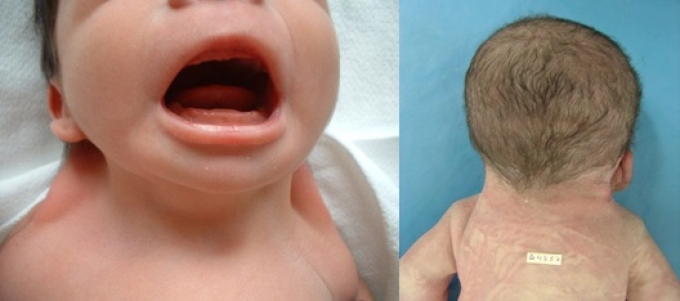

Correction of external disfigurements improves the patient's appearance, and thus enhances acceptance of the child by peers. The results of our study demonstrate that a plastic surgeon should become an integral part of this team. The team of specialists should include: endocrinologist, cardiologist, otolaryngologist, and gynaecologist. Patients with Turner's syndrome require complex multidisciplinary medical treatment. One girl was found with moderate unilateral recurrence of neck anomaly, 2 years after surgery. In the majority of patients postoperative results were very good, with the exception of two girls with webbed neck.
WEBBED NECK SYNDROME SKIN
Excision of skin lesions was performed in four girls. Two patients underwent breast augmentation. Auricular deformations were treated in two persons, whereas neck skin folds in six cases. Correction of epicanthus was performed in four girls, and blepharoptosis was operated in one case. We analysed 11 patients with Turner's syndrome, aged between 5 and 23 years, who underwent surgical treatment in our Department between 20. The aim of this study was to present the possibilities of surgical treatment in patients with Turner's syndrome and evaluation of postoperative results. From the point of view of plastic surgery the most important elements of therapy comprise the correction of webbed neck, developmental disorders in the palpebral apparatus or external ear, hypotrophic breasts and skin lesions. A wide spectrum of health problems in these individuals requires multidisciplinary medical care.

A typical form of this syndrome is related to the lack of one of sex chromosomes, and karyotype 45, X. This genetically determined pathology is characterized by numerous congenital malformations. Turner's syndrome occurs in 1 out of every 2000–2500 live-born girls. Z-plasty enables an adequate extension of scars and improves the contour of the neck. The lateral approach with a shift of glabrous skin flap to the back, which we performed, allows for effective reduction of the webbed neck, excision of bands of the connective tissue and correction of the low hairline on the side of the neck. The lower line of the scalp in the central part of the neck has remained unchanged. The performed surgical procedures enabled correction of low hairline only in the lateral parts of the neck. In one case, the correction was insufficient. One patient was found to have unilateral moderate webbed neck recurrence after about 2 years of treatment. In the case of four operated patients, the folds were completely removed and a correct symmetrical outline of the neck was obtained. In the case of all patients, the aim was to distribute the neck skin folds by using Z-plasty in conjunction with a shift to the back of glabrous skin flaps mobilised from the anterolateral surface of the neck. The age of patients ranged from 9 to 17 years. In the years 2000-2012, six children with Turner’s syndrome were treated because of the webbed neck deformity. The aim of the study was to present the possibilities of surgical treatment of a webbed neck of patients with Turner’s syndrome and the evaluation of treatment results. From the point of view of plastic surgery, one of the most important elements of the therapy is correction of the webbed neck deformity. A typical form of this syndrome is associated with a lack of one of the sex chromosomes (karyotype 45, X). This genetically determined pathology is characterised by multiple congenital anomalies. Turner’s syndrome occurs in approximately 1 out of every 2,000 to 2,500 live-born girls.


 0 kommentar(er)
0 kommentar(er)
